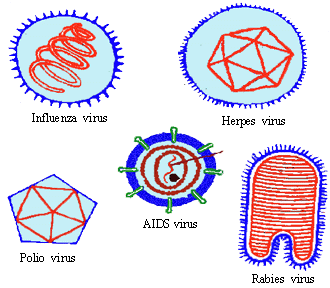|
PinkMonkey Online Study Guide-Biology
Pathogenic nature of virus
Viruses are causative agents of various dreadful diseases
in plants, domesticated animals and man. A number of plants like tomato,
tobacco, potato, sugarcane, etc. are affected and destroyed every year
by viruses. Many domesticated animals are also destroyed. The common mammalian
viral diseases are foot-and-mouth diseases of cattle, encephalomyeletis
of horse, distemper of dog, rabies, etc.
Common human diseases caused by viruses are mumps, measles,
chicken pox, small pox, herpes, influenza, common cold, jaundice, polio,
etc.

Figure 14.6 Pathogenic human viruses
|
Viruses and cancer
Cancer is an uncontrollable and unorganized growth
of cells causing malignant tumors, the cells of which have
the capacity to spread indiscriminately anywhere in the body.
Cancers grow by progressive infiltration, destruction and
penetration of the surrounding tissues. It is curable in the
initial stage but in the last stage called metastasia, the
tumors break apart and the cells spread to other organs, the
functions of which get disrupted, hence causing death of an
individual. In the past it was thought that cancer was not
caused by viruses, but in recent years, there have been increasing
evidences to prove that the cancer is caused by the DNA virus
called simian virus (SV-40) and a group of RNA viruses
called retroviruses. The cancer causing-viruses are
also called oncogenic viruses. Cancer can be cured
in its initial stages by radiation, chemotherapy and surgery.
Early diagnosis greatly decrease the hazards of cancer. It
is believed that viruses are involved in leukemia, sarcomas
and some kinds of breast cancer.
|
|
Virus and Aids
AIDS (Acquired Immune Deficiency Syndrome) is a
recently discovered sexually transmitted viral disease. It
is caused by Human Immuno Deficiency Virus (HIV), the target
cell of which is T4 lymphocyte of the host, which usually
forms the main line of defense. Due to failure of the human
immune system, sufficient antibodies are not formed and the
human body becomes susceptible to various infections. The
disease is transmitted during blood transfusion, through sexual
contact, from infected mother to the child during pregnancy
or through breast feeding . There is currently no cure for
AIDS. The treatment of AIDS, therefore, depends upon the efforts
to check the secondary opportunistic infections attacking
AIDS patients, as well as slowing or halting replication of
the HIV virus.
|
|
Table of Contents
14.0
Introduction
14.1 Kingdom
: Monera
14.2 Kingdom : Protista
14.3 Kingdom : Plantae
14.4 Kingdom : Fungi
Chapter
15
|